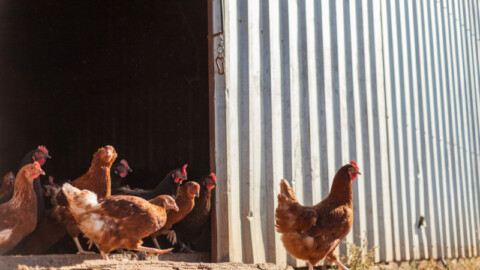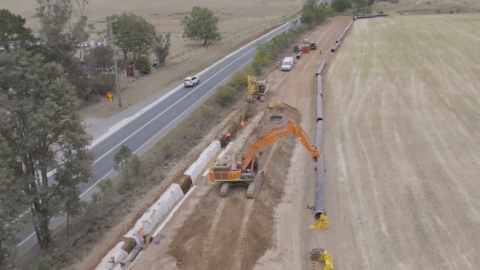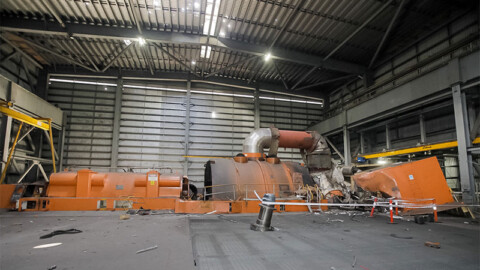The green energy transition is forcing companies and organisations to investigate ways that they can transition to greener options. With public-use buildings some of the biggest offenders in greenhouse emissions, local councils across the country are leading the way into the green energy transition, revamping emissions-heavy public buildings to be more environmentally friendly. As part of this transition, there is a strong push in the local government sector towards all-electric buildings powered by renewable energy. Pump Industry Magazine spoke to Brimbank City Council about its recent leisure centre revamp and heat pump installation that is setting the precedent for other councils to follow suit in the journey to all-electric.
In June 2020, Brimbank City Council endorsed the Brimbank Climate Emergency Plan 2020-2025 (Plan), which included a goal to reach net zero emissions by 2030 for Council operations, and by 2040 for the Brimbank municipality as a whole. Included was a commitment to assess the feasibility of electric alternatives to building new – or upgrading old – gas infrastructure in Council buildings.
Alongside the Plan, the Brimbank Environmentally Sustainable Design Framework (ESD Framework) establishes design and performance standards to reduce the water, waste and energy generated by Council’s buildings, including a requirement for Green Star certification.
The ESD Framework is designed to help reach environmental targets and demonstrate leadership and innovation in building performance. With the above regulations and guidelines in mind, Brimbank City Council planned to replace the old St Albans Leisure Centre with a contemporary facility to better meet the needs of the growing community. The St Albans Leisure Centre was built in the 1960s, with additional facilities added in 1985, including the indoor pool hall and gym.
Brimbank City Council Mayor, Bruce Lancashire, said Council had completed two feasibility studies on the replacement of the Centre before a decision was made. “The feasibility studies identified that the centre was outdated, which was supported by the aging assets and a poor standard of amenities and service areas when compared to contemporary standards.”
These issues were found to have negatively affected the Centre’s usage, particularly by casual users whose preference was to use more modern facilities. The reduction in usage and the increasing annual costs of labour, services and maintenance were significantly impacting on the annual operating cost of the Centre.
Around the same time that Council had plans to replace the Centre, an Advancing Renewables Program grant from the Australian Renewable Energy Agency (ARENA) became available.
“A shift from your standard gas-powered aquatic centre to one that was all-electric was endorsed and a decision was made to pursue funding in order to cover the extra costs of making the centre fully electric and renewable, which would help meet our net zero goals and to save on future gas use costs,” Mayor Lancashire said.
In considering the Centre redesign, a range of sustainable design features were included, including a 500kW rooftop solar system, rainwater harvesting, double glazing throughout, promotion of natural lighting, recycled content materials, reuse of demolition waste, water sensitive urban design and electric vehicle charging points.
A key ESD design feature was the all-electric, renewablespowered energy system which had been developed in parallel with a business as usual (BAU) gas boiler-based design option.
“This all-electric option is a nationally-significant project and is an important step towards Council’s ambition for zero net emissions by 2030,” Mayor Lancashire said.
“Compared to the BAU gas design, it will avoid 1,192 tonnes of greenhouse gas emissions per annum, which is represented as approximately 17 per cent of Council’s overall annual greenhouse emissions.”
Upgrading the aquatic centre
The road to updating the Centre has been a long one, with Council initially settling on the existing site as the preferred location for the development of a new leisure centre at the Council Meeting on 28 October 2014.
Council received an update about the replacement of the Centre at the Council Meeting on 12 December 2017. The report described the approaches to planning for the Centre, including infrastructure planning and a partnership approach that aimed to:
- Ensure the redevelopment also delivers significant measurable social and health benefits to the community, and leverages the benefits of co-located services
- Build strong community collaboration built on collective impact principles and commitment to delivering measurable social and health outcomes over time
- Develop at least one targeted intervention with measured outcomes suited to securing social finance, and leverage the collaboration with multiple service providers
- Become an example of how to combine social health outcomes with infrastructure redevelopment
Selecting the right pumps for the job
The initial concept design of the upgrade project recommended a four-pipe low charge ammonia (LCA) heat pump system, but this was changed to a four-pipe Hydrofluro-Olefins (HFO) heat pump system during the procurement process.
Brimbank Acting Director Infrastructure and City Services, Tom Razmovski, said, “Both options were assessed as being capable of providing the facility’s year-round heating and cooling requirements without resorting to backup gas boilers.
“The decision to proceed with the HFO heat pump option was based on the lower capital cost associated with this type of heat pump. The decision also took into account the HFO option’s energy efficiency and performance capabilities.”
Although the HFO efficiency and performance is lower than the LCA option, its parameters were sufficient to meet the project’s overarching objective of an all-electric, net zero greenhouse emissions leisure, aquatic and wellness centre.

Heat pump optimised pool AHU heat recovery system (80 per cent efficiency).
The specifics of the pumps selected
The chosen heat pump equipment provides the energy for domestic hot water and direct pool heating, and is required to meet the heating load of the HVAC equipment within the facility.
When it comes to aquatic centres, the requirement for HVAC is critical to the function and operation of the facility, specifically:
- Heating of water for pools
- Heating of air in pool spaces – with pool spaces heated to similar temperatures as the pool
- Heating and cooling of ancillary spaces
- Domestic hot water Since the upgrade to the Centre, heating and cooling water has been provided by three heat pump machines:
- A Climaveneta four-pipe Hydrofluro-Olefins heat pump unit to provide simultaneous heating and cooling (424kW cooling capacity, 419kW heating capacity)
- A Mitsubishi two-pipe reverse cycle unit capable of producing heating or cooling depending on building demand
- A Mitsubishi two-pipe heating only unit sized to complete heating capacity demands of the building
The four-pipe chiller/heat pump is supplied by Mitsubishi Electric (Climaveneta) and is manufactured in Italy, while the two pipe chillers/heat pumps are supplied by Mitsubishi Electric and manufactured in Japan.
The heat pumps are complemented by thermal storage with a capacity of 88,000L, a heat recovery system and other environmentally sustainable design features, including 500kW rooftop solar system, which enable efficient electric functionality.
This new equipment creates an all-electric plant which can be powered by solar and renewable electricity as opposed to a traditional gas boiler system used for heating water.
The four-pipe chiller/heat pump
One of the key advantages of this equipment – which is an especially important feature for an aquatic centre – is the pump’s capability of outputting simultaneous heating water and cooling water.
“In an aquatic centre we take advantage of this as we generally always have a heating load,” Mr Razmovski said. “This means if this chiller is heating, the cooling circuit is almost free cooling, as making the cooling water cold is a byproduct of making the heating water hot.”
Key details of the four-pipe chiller/heat pump include:
- Manufactured by Climaveneta
- Model ERACS2-Q-G05
- CHW flow/return temperature 0°C 7/13
- 425kW cooling capacity
- CHW flow rate 16.95L/s
- Cooling – total input power of 150kW
- HHW flow/return temperature 0°C 48/40
- 419kW heating capacity
- HHW flow rate 12.94L/s
- Heating – total input power 143kW
- Heat rejection method air-cooled
- Compressor type screw
- Number of stages – six
- Refrigerant R513
- Sound power level of 99dBA
The two-pipe reverse cycle unit
The two-pipe reverse cycle unit is capable of producing heating or cooling depending on building demand.
Key details of the two-pipe reverse cycle unit are as follows:
- Manufactured by Mitsubishi
- Model EACV-M1500YCL
- Number of modules: two
- CHW flow/return temperature of 0°C 7/13
- 296kW cooling capacity
- CHW flow rate of 8.89L/s
- Cooling – total input power 88kW
- HHW flow/return temperature 0°C 48/40
- 328kW heating capacity
- HHW flow rate of 11.95L/s
- Heating – total input power of 91kW
- Heat rejection method air-cooled
- Compressor type inverter scroll
- Number of stages – N/A (turn down to ten per cent)
- Refrigerant R32
- Sound power level of 83dBA
The two-pipe chillers/heat pumps
The two-pipe chillers/heat pumps are full inverter compressors, which is generally not normal for large chillers, and are very efficient module types. Mr Razmovski said, “Being inverter compressors means that they can operate from around five per cent of capacity up to 100 per cent of capacity with a lot of capacity steps in between. On a conventional chiller with fixed speed compressors this is not an option. “We generally operate at two steps (i.e. 50 per cent and 100 per cent)
Key details of the two-pipe heating unit are as follows:
- Manufactured by Mitsubishi
- Model EACV-M1800YCL
- Number of modules: three
- HHW flow/return temperature 0°C 48/40
- 533kW heating capacity
- HHW flow rate 15.92L/s
- Heating – total input power 162kW
- Heat rejection method air-cooled
- Compressor type inverter scroll
- Number of stages – N/A (turn down to ten per cent)
- Refrigerant R32
- Sound power level 85dBA
Heat pump installation and integration
Mr Razmovski said installation of the pumps and other equipment was not dissimilar to other large-scale projects. “Once the design, engineering and drafting is carried out our installation crew follow schematics and drawings as normal,” Mr Razmovski said.
“The large chillers, tanks, pumps and boiler were all craned into place on concrete plinths; we erected hurdles and then the pipework installation started.” The installation of the heat pumps was designed to meet the maximum heating and cooling requirements, and were installed throughout the facility (ground outside, roof and plant room).
Additionally, the sizing of the heat pumps was selected to accommodate the max building operating load and provide year-round electric operations. Mr Razmovski said that certain measures were undertaken to reduce redundancy in the new centre. “To assist with redundancy, a thermal storage system was included.
While this provides some redundancy by adding additional capacity to the system, it also allows our control strategy to take advantage of times where heat pump efficiency is higher, which allows the storage of heat to be used in less favourable times. “A gas boiler was also installed as a backup device to supplement any operational issues with regards to the heat pump units.”
Not all smooth sailing
The installation of the new pumps was not without its challenges, and necessary allowances needed to be made for the new equipment.
“The original design with boilers meant we would have a heating water temperature (boiler output) of 70°C to work with. Moving to electric heating using heat pumps, we needed to design to around 48-50°C as this is the maximum they can currently output,” Mr Razmovski said. This kind of change often results in design challenges as water flow rates need to increase significantly to deliver the same capacity.
Additionally, pipework and pumps need to be increased to deliver the additional flow rates required with a lower supply water temperature. Coefficient of Performance (COP) analysis for heat pump systems can be quite complex, the operations crew found out as challenges arose in determining the most efficient way to deliver the buildings heating and cooling load.
“Ambient temperature and the operation of units at different capacities were crucial factors in attempting to understand and ensure the systems were at optimum performance capacity range,” Mr Razmovski said. “During installation, this resulted in us having to use conservative measures when determining sizing and heat pump capacity, given the unknown elements and unprecedented nature of the project.
“An example of how this applied to installation is the change from a gas boiler to heat pump hot water generation, the aquatic heat exchanger used to heat the pools needed to be upsized to accommodate the lower primary water supply and return temperatures.
“It was determined that each coil had to generate the equivalent heat capacity with a primary water temperature of 45- 55 degrees. This resulted in an expansion of the capacity of heat pumps and in turn an increase to the project costs.”
Despite these challenges the Centre upgrade has already reaped the benefits of the change, with Mr Razmovski saying saying the site illustrates Council’s commitment to its net zero emissions targets. “The increase in gas prices and the possibility of future gas supply issues have resulted in operational cost savings for this all-electric facility,” Mr Razmovski said.
“Storage and solar capability have allowed for the production of energy to offset the energy use of the site.” Council reported that there have been no complications with the system since its installation.
Henceforth, the ongoing services for the new equipment and pumps include quarterly services carried out by a mechanical contractor and Mitsubishi Electric maintain pumps/chillers quarterly, alongside a mechanical contractor.
Progress to net zero pledges
Brimbank Council Director City Development, Kelvin Walsh, said that a key measure in achieving its goal to net zero emissions for Council operations by 2030 will be to disconnect all Council facilities from the gas network.
“As gas is a fossil fuel it cannot be made renewable. Alternatively, our electricity supply is 100 per cent renewable. Council generates renewable electricity through rooftop solar systems on our facilities.
Our remaining electricity needs are powered from wind farms in regional Victoria via a long-term contract with Red Energy as part of VECO – the Victorian Energy Collaboration. “Council owns and operates two aquatic centres,and the heating and cooling requirements for water and air conditioning mean these are the most energy intensive of our facilities.
“Being able to showcase the most modern energy efficient technology to make our new Brimbank Aquatic and Wellness Centre fully electric and renewable was an essential and huge step on our 100 per cent Renewable Brimbank journey.”
As the first all-electric aquatic centre in Australia powered by 100 per cent renewable energy, the Brimbank Aquatic and Wellness Centre is a shining example of how other councils around the country can work towards their own emissions reduction targets.
“As part of our funding agreement with ARENA, we are committed to a number of knowledge sharing outreach projects and reporting. As part of this we have developed the All-Electric Councils Foundation paper – a guide for councils to electrify everything,” Mr Walsh said.
“We have already had a lot of interest in the model and have been able to provide support and advice to other councils in Victoria and New South Wales in developing their new centres. “So far two tours and seminars for industry professionals have also been held at the Centre.”

500kW solar PV system.
Taking the next step
With the new Centre completed and already proving its worth, Council is turning its sights onto the future and the next course of action for an all-electric future.
“We’re working on our actions as outlined in our Climate Emergency Plan 2020-2025 to decarbonise our facilities and provide support to the wider municipality. Our goal is to reach net zero emissions for council operations by 2030 and for the Brimbank municipality by 2040,” Mayor Lancashire said.
“We’re continuing to support our community to transition to all-electric and renewable energy through our 100 per cent Renewable Brimbank Program and our Climate Emergency Community Grants Program.”
The Brimbank Aquatic and Wellness Centre is supported by a $2 million grant from the Victorian Government. The Australian Government committed $1.53 million towards an integrated renewable energy system, through the Australian Renewable Energy Agency’s (ARENA) Advancing Renewables Program.















